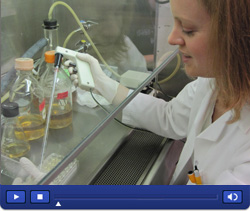UC San Diego Biologists Unravel Mechanisms of How Immune Cells Move
MAY 17, 2010
By Kim McDonald

UCSD’s Pascale Charest discovered a novel underlying mechanism that helps direct white blood cells to sites of infections. View a video of moving cells
Human white blood cells navigate to and destroy bacteria by following a chemical that bacteria secrete. But less well understood are the biochemical processes within these immune cells that allow them to speed their way to bacteria and the sites of wounds and infections, often causing inflammation.
Now a team of biologists from the University of California, San Diego, led by Richard Firtel, a professor of biology at UCSD, has uncovered a major piece of the puzzle. In the May 18 issue of the journal Developmental Cell, the UCSD scientists report that they discovered a previously unknown complex of proteins that guides amoebae and mammalian immune cells toward their prey.
The team's discoveries were made in Dictyostelium, a simple social amoeba and model genetic system that exhibits many of the properties of human white blood cells. This amoeba is controlled by the same navigation system as mammalian immune cells, but has a much simpler genetic system and can be grown more easily and rapidly in a laboratory than mammalian cells.
Working in collaboration with UCSD biology professor Steven Briggs and Zhouxin Shen, a senior scientist in Briggs' laboratory, Pascale Charest, a postdoctoral fellow in Firtel's UCSD laboratory and the first author of the paper, discovered a large multi-protein complex, called the "Sca1 complex," and found that it controlled the action of another protein called "Ras," known to be important in directing a cell's movements.
Ras connects the cell's direction-sensing compass to its molecular motors, which allows the cell to move toward its targeted prey by making actin in the parts of the cell closest to the food and then taking the actin away from the other ends of the cell. The Sca1 complex acts as a navigator, activating Ras only at the correct spot along the cell's surface and thus defining the direction of cell movement.
This constant extension and contraction of the cell's contents, which occurs over a period of about two minutes, is controlled by Ras and the Sca1 complex, and by another complex of proteins called TORC2, for Target of Rapamycin Complex 2, which helps in the chemical navigation system of the amoeba.
The UCSD biologists found that TORC2 inhibits the actions of the Sca1 complex and Ras in a way that allows the cells to regulate their own molecular motors, damping down their activity like a thermostat that shuts off the furnace when the room temperature gets too high or letting the activity continue.
"We knew before that Ras and these other components were at the front of the cell, but we had no idea how they got there and how they were turned on," said Firtel.
"We now have a better understanding of how white blood cells find their way to an infection," he added. "And we now know that these cells move in a highly regulated way. The discovery that Pascale made is more than just another cog in the wheel of understanding how these cells move. She's found a novel underlying mechanism."
The new findings not only improve our understanding of how mammalian cells and amoebae move, they are likely to guide the development of new drugs that control inflammation and limit the spread of tumors within the body caused during metastasis, when cancer cells use the same internal compass to home in on blood vessels and spread.
"Knowing all of the players and how everything works in cell movement, we can now offer drug companies more biochemical targets to reduce inflammation and metastasis," said Charest.
"With these discoveries, we are now closer to understanding how white blood cells move to sites of infection," said Firtel. "And if we now understand the biochemical pathways at this level, we can intercede in a way that will allow us to control inflammation and the metastasis of cancer."
The researchers added that how these protein complexes regulate one another to limit or enhance cell movements is critical in designing new drugs that can control inflammation, such as arthritis, or the metastasis of tumors.
Funding for the research effort was provided by the National Institute of General Medical Sciences, a part of the National Institutes of Health.
Related Links